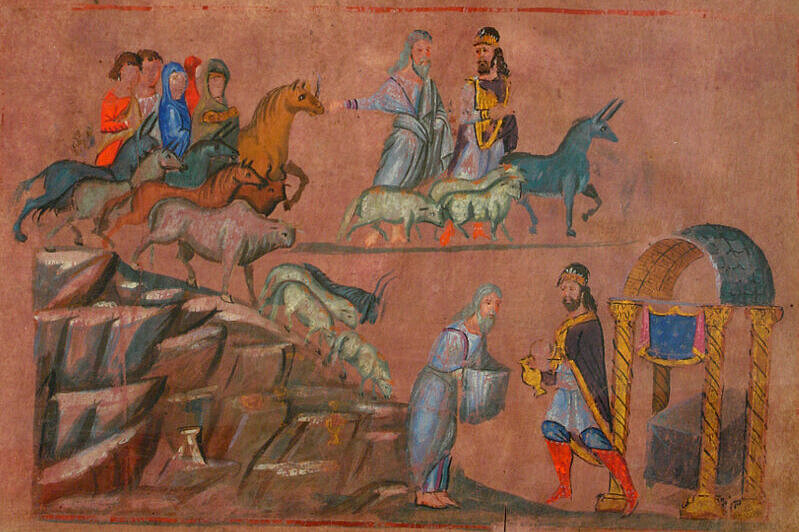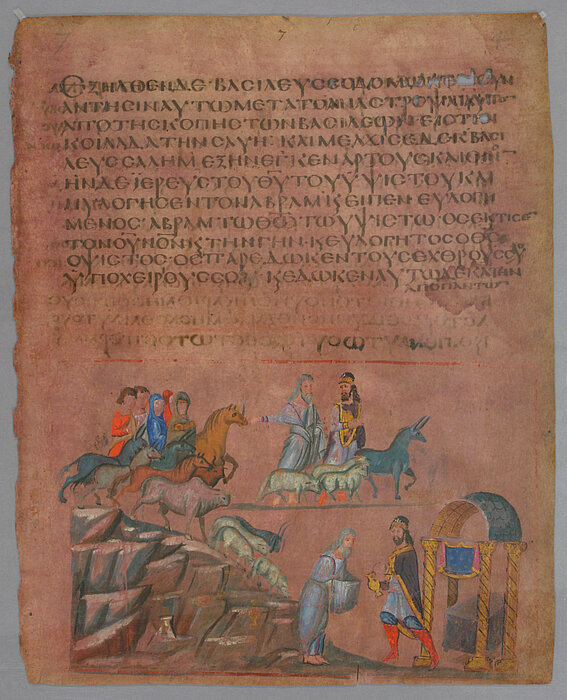Vienna Genesis
Forschung

Vienna Genesis (Cod. Theol. gr. 31): is famous for its illuminations, the richest preserved biblical cycle from the 6th century A.C. Corrosion of the silver ink has degraded the parchment folios. An FWF project investigates art technology and options for conservation.
Material analysis and conservation of a late antique illuminated manuscript on purple parchment
Author: Christa Hofmann
The Vienna Genesis is a fragmentary Greek manuscript of the Book of Genesis written on purple dyed parchment with silver ink. Dated to the 6th century, the 24 preserved folios are assumed to have been made in Antioch in today´s Syria. The Vienna Genesis is famous for its illuminations, the richest preserved biblical cycle from the transition period between antiquity and the Middle Ages. The silver ink´s corrosion, which has resulted in extensive damage to the parchment, was observed as early as 1664 when the manuscript was incorporated into the court library. From 1895 to 1975 the 24 sheets with text and miniatures on both sides were stored between glass plates. In 1975 they were conserved with parchment glue containing acetic acid and since then they have been stored between acrylic sheets at the Austrian National Library.
The aim of the project is to determine whether or not the current storage system poses a risk and if procedures to stabilise losses in the parchment and the development of a new mounting system can improve the preservation of the manuscript. The optimal storage conditions have to be found which prevent further corrosion of the silver ink and deterioration of the parchment. A thorough analysis of the parchment, the purple dye, silver inks and pigments of the miniatures is necessary in order to decide how to best conserve the Vienna Genesis. Urgently needed stabilization of losses in the unusually thin parchment will capitalize on methods recently developed at the Austrian National Library. Whether the parchment was dyed with shellfish purple or other organic colorants will influence decisions regarding the future storage of the manuscript. There is no surviving written record describing the production of parchment and how it was dyed purple in late antiquity. An investigation of the parchment and purple dye of the Vienna Genesis will provide insight into these early practices and help understand how knowledge and technology were transferred in the transition period between antiquity and the Middle Ages. A detailed analysis of the pigments in the miniatures will help to clarify questions concerning how many artists were involved in painting the illuminations and if any alterations were made at a later date. As one of the best preserved examples of late antique book art the investigation of the Vienna Genesis will greatly expand present knowledge about late antique, Jewish and early Christian cultures.
The project started at the Conservation Department in April 2016. The following project partners and their teams are involved in art technological and conservation research.
Data concerning the research project
Title | Vienna Genesis (Cod. Theol. gr. 31) Material analysis and Conservation of a late antique purple manuscript |
Funding | FWF Austrian Science Fund |
Duration | April 2016 to March 2019 |
Project leader | Christa Hofmann (ANL) |
Project team | Sophie Rabitsch |
Project partners | Martina Griesser, Conservation Science Department, KHM, Vienna Klaudia Hradil, X-ray Centre, TU Wien Bernhard Pichler, Rudolf Erlach, Institute for Art and Technology, University of Applied Art, Vienna Abigail Quandt, Department of Conservation and Technical Research, The Walters Art Museum, Baltimore, USA Maria Joao Seixas de Melo, Department of Conservation and Restoration, New University of Lisbon, Portugal Maurizio Aceto, Dipartimento die Scienze e Innovazione Tecnologica, Università degli Studi del Piemont Orientale, Alessandria, Italy Jiri Vnoucek, Preservation Department, The Royal Library, Copenhagen, Denmark Matthew James Collins, BioArch, Department of Archaeology, University of York, United Kingdom |
Bitte beachten Sie die Öffnungszeiten zu den Feiertagen.



